

The parts of a specimen
can be stored in several
collections. To see the place where a
specimen or parts of it are stored use the lower tree and
click on the
 icon to select the display according to the collections as shown
below and in a short tutorial
icon to select the display according to the collections as shown
below and in a short tutorial
 .
.
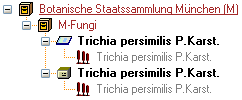
In the tree shown above
select the collection
 to display the data
fields as shown below.
to display the data
fields as shown below.
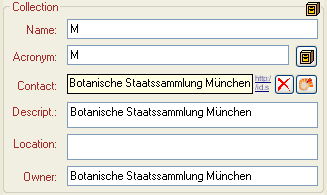
To be able to edit the details of a collection, you must be a collection manager of this collection. The restrictions for the access for editing the collections are defined in the CollectionManager section.
At the base of the fields you find
the
default collection, used for the creation of new specimen parts.
Specimen parts that are not created
as a part of another part will be placed in this collection.
Use the
 button to edit this entry (see below) For another possiblity to edit this value
choose Administration - Customize display from the menu.
button to edit this entry (see below) For another possiblity to edit this value
choose Administration - Customize display from the menu.

If you need further information
about a collection
click on the  button or choose
Administration
- Collections... from the menu to open the window for the
collection administration (this menu entry is only available
for collection managers). This will open a window (see below)
where you
can edit the collections used in
your database for which you are a
collection manager.
You can choose among several options to show resp. hide the hierarchy:
button or choose
Administration
- Collections... from the menu to open the window for the
collection administration (this menu entry is only available
for collection managers). This will open a window (see below)
where you
can edit the collections used in
your database for which you are a
collection manager.
You can choose among several options to show resp. hide the hierarchy:
 Show whole hierarchy
Show whole hierarchy  Superior datasets
and children of current dataset
Superior datasets
and children of current dataset Restrict to superior datasets
Restrict to superior datasets Hide the hierarchy
Hide the hierarchy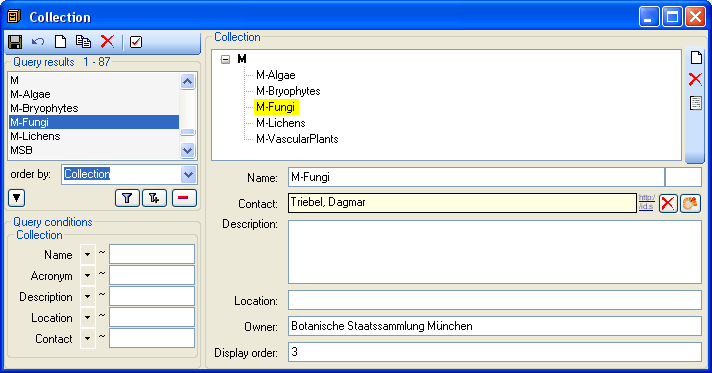
With the
 botton, you can display the
specimen stored in a collection within the hierarchy (see
below).
botton, you can display the
specimen stored in a collection within the hierarchy (see
below).

As an alternative the specimens stored in a
selected collection can be
listed in the specimen list. You can hide /
show this list using the  /
/ button. The specimen list will appear as
shown below. Click on the
collection in the tree view to fill the list and see the
specimens that contain
parts which are placed in the current collection. To transfer
the parts of
certain specimen from the current collection to another
collection, choose them
in the list and click on the
button. The specimen list will appear as
shown below. Click on the
collection in the tree view to fill the list and see the
specimens that contain
parts which are placed in the current collection. To transfer
the parts of
certain specimen from the current collection to another
collection, choose them
in the list and click on the
 button. To change to a specimen
from this list click on the
button. To change to a specimen
from this list click on the  button.
button.
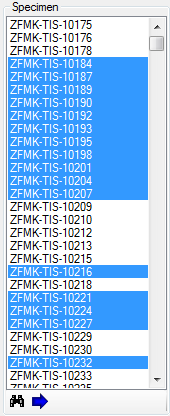
As an alternative you may select the specimen in
the main form a choose Data -
 Transfer -
Transfer -  To Collection ... from the menu. A window will open where you can
select the collection in which you want to transfer the specimen. With this
option ALL parts of the selected specimen will be
transferred into the selected collection.
To Collection ... from the menu. A window will open where you can
select the collection in which you want to transfer the specimen. With this
option ALL parts of the selected specimen will be
transferred into the selected collection.
To create a new collection use the
![]() button either above the Query results or the
button either above the Query results or the ![]() button right of the hierarchy, where
the new
collection will be placed underneath the collection selected in
the hierarchy.
To copy a collection either use the
button right of the hierarchy, where
the new
collection will be placed underneath the collection selected in
the hierarchy.
To copy a collection either use the  button
or the
button
or the  button. The
latter will copy
the collection including all child collections. To set the
superior collection,
use the
button. The
latter will copy
the collection including all child collections. To set the
superior collection,
use the  button. The user creating the new collection will
automatically be inserted as a collection manager for this collection.
To remove
button. The user creating the new collection will
automatically be inserted as a collection manager for this collection.
To remove  a collection, any collection manager must
be removed from this collection first. Click on the
a collection, any collection manager must
be removed from this collection first. Click on the
 button to open a window
for the administration of the collection managers. For new versions of the
database the removal of the link of collection managers to deleted collection will be done automatically.
To transfer collections in the list as children into another collection,
click on the
button to open a window
for the administration of the collection managers. For new versions of the
database the removal of the link of collection managers to deleted collection will be done automatically.
To transfer collections in the list as children into another collection,
click on the
 button in the upper left corner.
button in the upper left corner.
To administrate the types for the collections,
click on the
 button. A window will open where you can create new
types and add icons representing a type (see below).
button. A window will open where you can create new
types and add icons representing a type (see below).
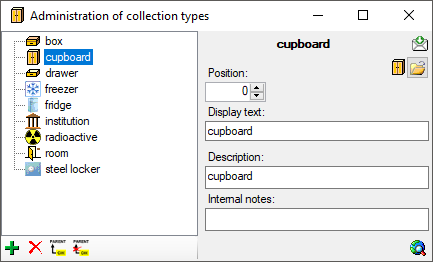
The type
 regulation is provided for the collections that are meant to
administrate the access to transactions of the type regulation. See
chapter
Transaction or further details.
regulation is provided for the collections that are meant to
administrate the access to transactions of the type regulation. See
chapter
Transaction or further details.

If there are images depicting the collection a
yellow background  will indicate the availability of these images. To show the images,
click
on the
will indicate the availability of these images. To show the images,
click
on the  button. This will open the
area for
the images as shown below. Use the
button. This will open the
area for
the images as shown below. Use the
![]() and
and
 buttons to add or delete images of your
collection. For
further details about handling images see chapter Images.
buttons to add or delete images of your
collection. For
further details about handling images see chapter Images.


If a floor plan is available for a collection
this will be indicated by a yellow background
 . For details see
chapter collection floor pan.
. For details see
chapter collection floor pan.

To print labels for e.g. drawers, click on the
 button. The area for printing the
labels will be shown (see below). Further details about printing labels are
described in the chapter Label.
button. The area for printing the
labels will be shown (see below). Further details about printing labels are
described in the chapter Label.
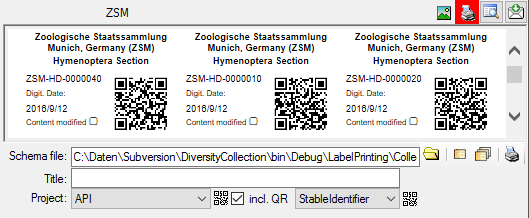
To edit the contents of the tables in
the table editor select
 -
-  Collection
resp.
Collection
resp.
 -
-  Image
from the menu. For Details
see chapter TableEditors.
Image
from the menu. For Details
see chapter TableEditors.
To view the history of a dataset,
click on the
 button. A
window with the
history will open. For more details see chapter History.
button. A
window with the
history will open. For more details see chapter History.
For details about handling data see the Data section. Data of the collections is stored in the table Collection.